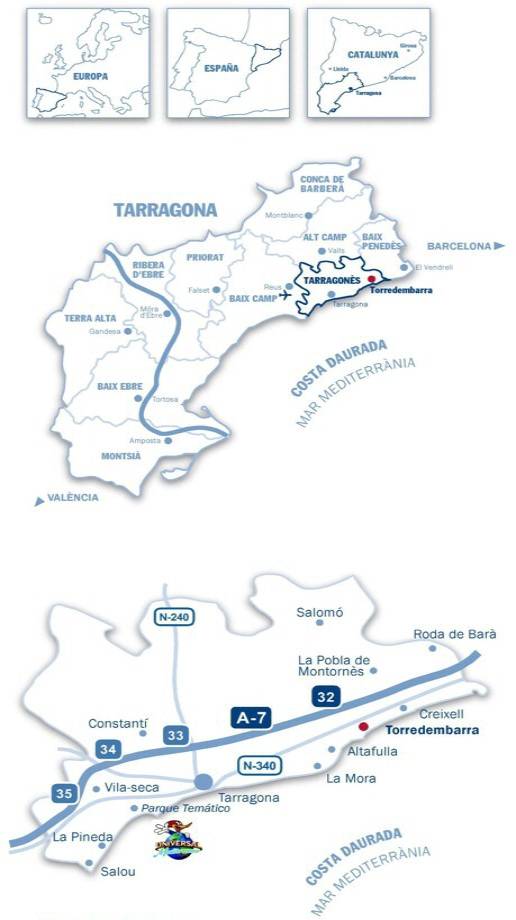
5. Economical activity
6. Gastronomy, festivities and traditions
1.1. LOCATION:

1.2. GENERAL DESCRIPTION:
At the beginning of the 20thcentury, Torredembarrawas a rural area, since its population was not superior to 2000 inhabitants. The population was concentrated in small “nuclis” (for instance, Babilonia) and it was devoted to agriculture and fishing. Later it changed into a half-urban town due to immigration.
Nowadays Torredembarra is a tourist and commercial village. It is located in a nucleus of communications: roads (N-340), freeway (A-7, exit 32) and train (own station, Corridor of the Mediterranean).
Several areas of population form the village of Torredembarra. It has an extension of 857,81 ha and a stable population that already overcomes the 12.000 inhabitants. It is located 14 Km. from the Roman Tarragona and 85 Km. from the cosmopolitan and olympic Barcelona, and not very far away from the Cister route, from the thematic park Port Aventura, and from the natural park of the Delta del Ebro. It also has several golf clubs and a wide cultural, sportive and entertaining offering.
The most important building in Torredembarra are:
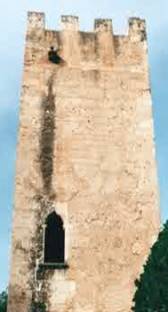
Torredembarra has great beaches too (“Paella beach” and the beach of the maritime area) and a dune ecosystem typically coastal with semimovable dunes and salty small lakes. The beach is included in PEIN (Project about Interesting Natural Places) of the Generalitat. It is 2150 meters long and a medium width of 85 meters.
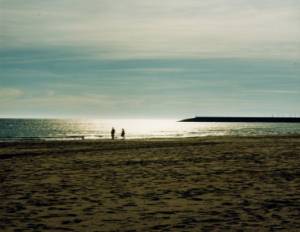

Author: Sandra Carbonell
1.3. DEMOGRAPHIC EVOLUTION:
The origin of our village is medieval and according to the first demographic references in 1358 the village had 28 fire places (or families) in Torredembarra and 3 in Clarà.
Later, at the end of the 18th century, Torredembarra’s population increased from 300 inhabitants to 400.
In 1718, Torredembarra (without taking into account Clarà) had 900 inhabitants approximately. In 1787 this quantity increasedto 1900.
The population of Torredembarra decreased during the first half of the 19th century, but in 1857 it increased again to the 1900 inhabitants that it had formerly.
Between 1860 and 1870 the neighbourhoodsdecreased again (from 2000 residents to 1850).
In spite of this, the village enlarged during the following decades (in 1880, 2650 inhabitants; in 1890, 2750 inhabitants).
In any case, the demographic variations didn’t finish. In the 90s, the population decreased down to 1900 people.
After the loss of Cuba and Puerto Rico the request of barrels for the export of wines and liquors decreased and many barrelers lost their jobs.
The consequence of this was that 700 people with no job left the village.
The first decades of the 20th century remained marked by the demographic stagnation but from 1930 onwards it was recovered.
In the period between 1936 and 1939 (the Civil Spanish War and the postwar period) the population stagnated, and even in 1960 a growing immigrant population started. It hasn’t finished nowadays.
First, the demographic increase in 1960 was due to the immigrants of Conca, Jaén and Sevilla, that came attracted by the building offer.
In 1970 Torredembarra had 3750 inhabitants; in 1980, 5469; and in 1990 6560.
Today the population of Torredembarra is about 14250 although during thesummer is between 35000 and 40000 inhabitants approximately because there are a lot of second residencies that fill in during the holiday period.
Nowadays we can divide the new immigrants in two main groups: those who come from North Africa, especially from Morocco (because of the proximity) and those who come from South America because the language is also Spanish there.
Population in Torredembarra:
In the following graphic we can see the progressive increase of the population in Torredembarra (from 1998 to nowadays):
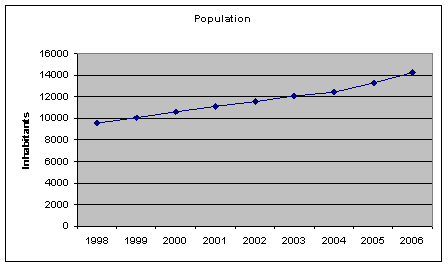
Immigration in Torredembarra:
The 17 % of the population in Torredembarra is immigrant. In the following graphic we can see it with their origin place.
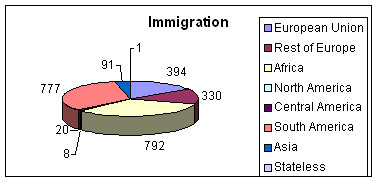
Taking into account the rests found in the Vil·la del Moro, Torredembarra was inhabited during de Roman period.
In any case, the first origin of the village date of the year 1057, when Ramon Berenguer I gave Clarà to Guitard, Polionish and Ollomar with the finality of repopulating and protecting the Baix Gaià. The condition was a tower outside Clarà should be built.
In 1235, the archbishop of Tarragona gave the parish depending from Tamarit to the inhabitants near this tower (in Torredembarra and Clarà).
As far as we know, the first knight of Torredembarra in 1206 was Ramon de Tamarit. The following one was his son; and then Albert de Vernet.
Bernat d’Olzinells bought the Vernet propriety in 1342. 49 years later, in 1391, Pere d’Icart had the rights over Torredembarra and enlarged them buying what Lluís d’Icart had done to Carles I of the crown rights in 1523.
The family remained in Torredembarra until 1663, when the last member of the Icart family died. From this moment on the baronage and the manor depended on Santa Coloma de Queralt counts.
Among all the historic institutions in Torredembarra, we can emphasize one: the figure of Juy de Prohoms (juridical part that defended the population interests). It was conceded to the village in June, 1524.
Author: Eduard Virgili
3.1. OUTSTANDING BUILDINGS:
· El Castell / The Castle (plaça del Castell, Casc antic)
It is the most important building. The he renaissance palace was built in 1565 by Lluís Icard, feudal Lord of the village. Pere Blai is believed to be the architect. It has been restored recently and his nowadays houses the town hall.
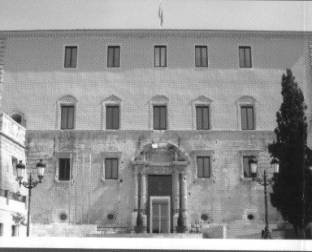 The base form is rectangular with four towers, one on each corner. One of that is nearly destroyed. The building has got three floors with many medium sized windows on each floor, what means that it wasn’t a war building, but a palace.
The base form is rectangular with four towers, one on each corner. One of that is nearly destroyed. The building has got three floors with many medium sized windows on each floor, what means that it wasn’t a war building, but a palace.
That building gives its name to the square that is found at the old town of the village where you can visit other nearby historical buildings of the same period of time.
· Església Parroquial de Sant Pere / The Church of Saint Peter(C/ Joan Güell, Casc antic)
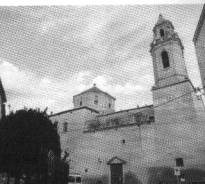
The current church was joined to the old one in 1680. Other ornamental objects were added such as the Saint Rosaline picture or the Barroque organ.
It is placed in front of the Castle square (on the left of the photograph).
· Quadre de Santa Rosalia / Saint Rosaline picture (Església parroquial de Sant Pere)
The picture is said to be found during the burbonic plague in the Middle Age. People say the epidemic disappeared thanks the picture thanks the picture. That is why there’s a procession commemorating this miracle on 15th July.
· L’orgue barroc / Baroque organ (Església parroquial de Sant Pere)
This baroque organ is dated from 1705 and has been restored a few years ago after the damages caused by the Spanish Civil War. Nowadays it is located in Sant Pere church.
· La torre de la vila / The tower of the village (C/ del Forn)
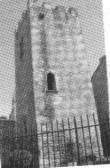
This medieval tower is believed to be built between during XII or XIII centuries and could be the remains of a castle. The tower is placed in front of the church in the old town and it could be the oldest building of the village.
· La muralla / The wall
Nowadays some parts of the old medieval wall of the village are still preserved. We can point out 2 main entrances into the old walled enclosure: Padrines in the castle square (C/ Riera – plaça del castell) and Bassa on (C/ Ample) street.
· La vil·la del Moro / Roman village
These roman remains are part of an old agricultural villa. We can distinguish three areas: The thermal group, the service area and the residential sector. It’s a medium sized villa with columns and capitols ans is surrounded by other buildings.
· Edifici Antoni Roig / Antoni Roig Building (C/ Alt de Sant Pere)
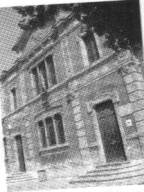
It was inaugurated in 1892 as a school. It’s of modernist style dated from the nineteenth century. Antoni Roig had the idea to build this school, after coming back from America bringing his own fortune.
· Hospital – Residència Pere Badia / Hospital - Residence (C/ Pere Badia)
This building was inaugurated in October 1824. It was built thanks to the Foundation for the assistance of sick and poor people created by Pere Badia. Nowadays this building is the old people’s home.
3.2. PLACES OF INTEREST:
In Torredembarra there are other outstanding places. The main street is Antoni Roig Street and it’s a good example of the urban expansion. which took place in the XVIII century
This street links the Joaquim Boronat square, or better known as “la plaça de les Monges” (The square of the nuns), and “la plaça de la Font” (The fountain square) that is near “la plaça de la Vila” (The village square).
3.3. ENTERTEINMENT:
In Torredembarra we can enjoy recreational zones and shops to have a great time can be found too.
The harbour is the most popular zone because there are many bars, ice cream parlours, different types of restaurants, pizzerias, discotheques and also because it’s a good place to take a walk. There is a lot of space too for all the yachts ships and if you are a water enthusiast there are many water sports you can enrol at the Sportive club of Baix a Mar “Club esportiu de Baix a Mar”.
If you want to know better about the sportive areas of Torredembarra, you can find the UDT where there are many sports zones such as football, petanca, athletics, tennis, swimming, basket and much more.
And if you want to have a great time there’s a pub (C/ Capella) with recreational machines, bowling, billiard, darts…
There are also many places where to rest as the Joaquim Boronat square (plaça de les “Monges”), the Fountain square (plaça de la font) and the “Escorxador” square where you can talk or stand with your friends sat on the bench or the chairs.
The most important shopping area is Antoni Roig Street that is placed from the Fountain square to the Joaquim Boronat square.
Author: Gerard Ayuso
In this part we are going to show you a sort of possibilities to do around Torredembarra:
Torredembarra, a wide range of possibilities. A walk full of history, tradition and nature. (2 days)
1st Day
Historical and commercial Centre
2 km
4.1. WITH A LOT OF PLEASURE:
Torredembarra has been a rural and sailor town since Middle Ages. A sample of this duality is its gastronomic offer. This harmony has blossomed in the elaboration of our "romescos, asmarris, alls cremats, xatons, suquets, etc…" and our seafood dish for excellence is the "Bull" (elaborated with the dry stomach of the tuna). Every year, in February, the Bull" has its specific gastronomic day.
Torredembarra is situated on a privileged site of the Costa Daurada (12 Km from Tarragona and 80 Km from Barcelona). Torredembarra has become one of the main tourist and commercial centers in this area.
In the old nucleus of Torredembarra, we find the Icart's Castle (XVIth century), Renaissance civil building. It is the current headquarters of the City council, and the Church of Sant Pere (1680) endowed with architectural and ornamental elements like the Baroque Organ. Facing it, raises the Tower of the Vil·la (XIIth - XIIIth century) of Mudejar style. We also find remains of the old defense wall with two of its gates (Basa and Padrines) and their buttresses.
Antoni Roig Street has become the commercial axis. It is where you will find most of the town's establishments. Some buildings of Baroque style (XVIIIth century) and others of modernist style (XIXth - XXth century) are also situated in this street.
2nd Day
Clarà, Els Muntanyans, Baix a Mar and the Seaport.
5 km
There are numerous pleasant routes that you can follow within the city borders of Torredembarra, walking or riding on bicycle. It is a pleasant way to have a look at the numerous dry stone shelters, many of which are conserved in a good condition.
We will begin the next tour from the church called "Sant Joan Baptista de Clarà" and the building of "Cal Xeco", built on the site of an old medieval castle. Going down to the beach where Mother Nature has provided us with a beautiful area of natural interest: the beach of the Muntanyans- with dunes and pond or swamps - and where many species of animals and extraordinary plants live.
Following the marine walk, we will go to "Baix a Mar" (the fishermen district- XVIIIth century) then to the Fishing and Leisure Port (with the new market where the fish auctions take place) and the cliffs with the last lighthouse built in the XXth century, concluding the itinerary in the "Cala de Canyadell". Canyadell is a beach next to Torredembarra’s port.
4.2. KNOW TORREDEMBARRA’S ROADS!!:
"l'Arbosserà" Way
"Molí" Way (A long time ago this way communicated “la Riera de Gaià” with “Creixell”. This way crossed Torredembarra.)
"Vell de la Pobla" Way
Total journey: 2.700m - Time: 45 minutes
We start the route from the IES Torredembarra (FAD Reward Architecture) to the bifurcation (220 m). Firstly, we will find a fence with a door made of iron grills. From here, we can appreciate a panoramic view of the north part of the Tarragonès: to the bottom, a mountain with the pick called "Mola"(318m).
We advise taking the way on the left, called "l'Arbosserà" since the journey is easier if one makes it on a bike. At the beginning of this way, we find the typical and rural Mediterranean landscape: olive trees, locusts, almond trees, hazel trees, pines, bushes and several aromatic and medicinal plants; along the whole itinerary we can observe borders of dry stone.
If we are good observers, we will be able to distinguish different classes of birds: blue, goldfinches, gulls, starlings, turtledoves, doves, etc.
Starting from the bifurcation, the way becomes narrower, and 350 m on the left, there is the entrance of a corral of sheep with a mill of wind.
A slight ascent begins and after a curve, some 140 m from the corral, we can observe on the right, the called "Roques Planes" (rocky formations, typical from the village) that appear later on again. On the right, about some 30 m from the road, there is a dry stone shelter (a place where rural men guarded against rain and kept their tools) in a quite good condition. The way begins a soft slope and there are thickets and pines on the left. At the end of this straight line, making a curve, about some 220 m from the dry stone shelter, we find the service way of the National Road 340 that coincides with our itinerary for about 70 m. This way is very frequented by trucks. At the beginning of the curve, we can see the highway and the freeway. On the left, there is an asphalted plant and, on the right, the Animals Protecting Society. Then, we find "L’Ermita de Montornès" and on the right "La Pobla".
Going to the right, we take the way called "Molí" that goes towards Creixell. From this road, we can observe some panoramic views of Clarà and of the Mediterranean Sea. Starting from here, we contemplate crop fields (olive trees, locusts...) of a very care aspect, where the leak system is used to water. Then, we find a crossing. If we turn on the right, we will be again at the starting point of the journey.
In the middle of the way, on the right, we will find a vineyard. There are olive trees in both sides. The borders are full of brambles that give us some moors at the end of the summer. We see plane rocks and a panoramic view again: on the right, the called "Pujol", a tank of water, the urban nucleus of Clarà, the Muntanyans and the sea. At the bottom, the white building of the High School and about 380 m far away, we find the initial bifurcation.
4.3. BEACHES:
The Paella
This beach is located in the Munts zone. It has an area dedicated to the sport practice. This beach is approximately 1 km long and has some areas whose spaciousness is about 90meters. If we follow the Maritime Walk, we will go to Baix a Mar (the fishermen district) then to the Fishing and Leisure Port (with the new market where fish auctions take place) and the cliffs with the last lighthouse built in the XXth century, arriving finally to the Cala de Canyadell.
Services
Baix a Mar Beach
It is located in the old fishermen district and goes from the Maritime Club to the Narcís Monturiol square. We also find here the Maritime Walk. It is about 700 meters long.
Services
The Muntanyans
You can play, sing, bathe in the sun and the sea, walk, seek seashells and other remains of sea life and relax in a horizontal landscape free of buildings, contemplating the ever-changing colours.When you are going out by the beach, please always use the boardwalks built for you. You may even be able to observe some of the birds and other forms of life if you walk quietly and carefully.
Natural and artificial elevations in the land have traditionally been used for agriculture. Whether these fields lie fallow or not, they are an important habitat promoting biodiversity, and they provide visual relief from the coastal landscape. Silt from higher ground deposits near the coast to create lagoons. Whether the weather comes from the sea, streams or rain, every summer these lagoons dry up as they have for millennia, leaving only a crust of salt on their surface.
Visitor, if you observe and deliberate, you will realise that the central coastline of Catalonia is practically one enormous, elongated city with its feet washed by the sea. There are practically no areas left without buildings, housing developments, boardwalks, ports or other constructions. This beach has maintained its dunes and lagoons or salt marshes since prehistoric times.
Services
4.4. ARCHITECTURAL AND ARTISTIC HERITAGE:
THE CASTLE (The Castle Square. Old nucleus):
The Castle: a history of more than 400 years.
The first phase of the restoration works ended in 1999 and the new Town Council offices were inaugurated on 25 March 2000, in the presence of the Right Honourable Chairman of the Generalitat, Mr. Jordi Pujol.
The criteria used for restoring the castle were respect for its structure and for surviving elements of interest, and the completion of an unfinished building.
The restoration and extension work required has been carried out as far as possible respecting and in tune with the form of the original building, but using contemporary architectural language.
BASEMENT: Cultural use (2nd phase)
FIRST FLOOR: To be completed in the second phase.
GROUND FLOOR: Control of access and information, general records, till, payments in person, land registry, general administration and records.
SECOND FLOOR: Meeting room, town hall offices, councillors’ rooms, treasurer’s and audit departments.
THIRD FLOOR: Technical services for town planning works, secretariat, legal department and offices of municipal groups.
The origins of the new Torredembarra Castle go back to the mid 16th century. On the death of Cristòfor d’Icart I d’Agustí, the lordship of Torredembarra passed to his son, Lluís d’Icart I d’Agustí. He, as the most prominent member of the family seat was not now in keeping with neither his responsibilities (from 1551 to 1580 he was General Mayor of Catalonia), nor the social prestige he enjoyed, and he ordered a new building.
The castle is built in the Renaissance style of the School of the Camp de Tarragona. An architecture that we should recall was still at an early stage in Catalonia.
The building was designed as a fortress residence to dominate the town. Square in shape and with four towers, one in each side, it stood at the highest point of the town. Following Mediterranean tradition, it had a central arcaded and porticoed patio, and its rooms were set out around this central patio. Between the main door and the patio there is a rectangular section that acts as porch, covered with the vault attributed to the master architect Pere Blai. The work began on the castle around 1565 and at least the most important sections were completed by 1580.
FISH MARKET
The fish auction in Torredembarra was restarted on 3rd April 2000, recovering in this way a historical tradition of the village. The fish market has a surface of about 350 meters and the dependences are the following ones: the room dedicated to the fish auction, the laundry of boxes, the ice factory, the scale, the center of shellfish expedition and the rest is dedicated to offices and services.
LA TORRE DE LA VILLA (C/ del Forn. Old nucleus)
It is located in front of Sant Pere Apostle church, inside the old nucleus of the town. It is the oldest building of the village, probably from the XIIth or XIIIth century, it is considered that it could be part of the old castle.
WALL
We conserve two of the entrance portals of the wall that surrounded the village in the XVIIth century: Padrines (highway La Riera-Plaça del Castell) and Bassa (Ample street). There are also remains of a buttress in the Mañé i Flaquer street.
LA VIL·LA DEL MORO (Roman Style)
It is formed by a group of structures that would correspond to three occupation phases: thermal group, services area and residential zone. It is a middle rate village that had an atrium with columns and capitals of rough order, around which several dependencies are distributed.
The study of the discovered remains allows us to distinguish two constructive phases. The first one belongs to the republican time, from the beginning of Ist century before Christ until Ist century after Christ, and the second one to the august time, from Ist century after Christ up to IInd after Christ. The diverse excavations have provided ceramic remains, mosaics, conductions of water and diverse tools.
ESGLÈSIA PARROQUIAL DE SANT PERE (C/ Joan Güell. Old nucleus)
The current church together with the old one had just built in 1680. Later on, in the XVIIIth century, the temple was endowed of good part of its architectural and ornamental elements: baroque organ (1705), the steeples, cruise and the “ábside”(1771-1778).
SANTA ROSALIA'S RETABLE
It is that that the population adore from the miracle in 1640.It is the religious patronage feast.
The tradition tells us that a pilgrim, knowing about the plague that whipped the territory, advised all the ill people going to Tarragona, to a house placed in Cavallers street and looking for the saint's retable in order to put themselves trust in her.
THE BARROQUE ORGAN
It is an organ of Baroque style (1705). It was restored some years ago.
EDIFICI ANTONI ROIG (C/ Alt de Sant Pere. Old nucleus)
It is located in Alt de Sant Pere Street. It was inaugurated in 1892 as a headquarters of the schools financed by Antoni Roig, a Latin American man that made fortune in America. At the moment, it is the headquarters of: the Antoni Roig Board, the Municipal School of Music, the School of Adults, the Point Òmnia, the Point of Youth Information, the Capicua Centre, the Point of Occupational Information, and some other entities…. It dates from the end of the XIXth century and it is of modernist style.
HOSPITAL-RESIDENCIA PERE BADIA (C/ Pere Badia. Enlarge)
It dates from the end of the XVIIIth century and it is of Baroque style. The Hospital was founded to attend the poor sick people of the village, and it belongs to the foundation that Pere Badia established in 1793. It was inaugurated in October 1824. Pere Badia is an illustrious man of Torredembarra who made fortune in America like others. At the moment, the building is a residence for old people.
CAL XECO (Plaza de l’Esglèsia. Clarà)
It is a cultural building of local interest, framed on the old castle of Clarà, of the medieval time.
Apart from these relevant buildings, the village of Torredembarra has another buildings and streets. For example, Antoni Roig Street, which is a sample the city-planning expansion of the village in the XVIIIth century. In this street, we can find buildings from the XVIIIth century (Baroque style) and others from the XIXth and XXth centuries (modernist style). There are also modernist buildings in the Plaça de la Font and Baroque buildings in the Plaça de la Vil·la. The main streets of the Old Nucleus (C / Ample, Baix de Sant Pere, Alt de Sant Pere, Eduard Benot, Carnisseria, etc.) have also buildings of interest, mainly from the XVIIIth and XIXth centuries.
From Torredembarra:
14 Km. Tarragona
30 Km. Reus Airport
30 Km. Route of the Cister
85 Km. Barcelona
90 Km. Ebre's Lands
275 Km. València
Authors: Carolina Martínez and Guillem Tenza
6.1. GASTRONOMY:
Gastronomy, tourism and commerce are necessary complements for a city promotion. In Torredembarra the offers a lot of fish and sea fish like Mediterranean diet. Mediterranean cooking combines sea and mountain food. The most important dish in Torredembarra is “Bull Mariner”.
“BULL MARINER” RECIPE (for 4 people)
Ingredients:
-1/4 kg of bull (the gut of salted and dry tuna)
-1 tomato
- 2 kg potatoes
- ¼ of boiled haricot beans
- ¼ olive oil
- Salt
- 4 o 5 toasted almonds
- A slice of bread
- Water.
Preparation:
Leave the “bull” to soak for 24 hours. Scrape it with knife.
Boil it unsalted for an hour without cutting.
Remove it and cut the “bull” into little pieces.
Fry a tomato, a slice of bread and 4 or 5 garlic cloves and afterwards mince them with a dozen of toasted almonds, a cup of water and a previously fries pepper.
In a pot, put ¼ l. of olive oil and when it is hot and steaming hot put the mince and the lid on.
Later add the “bull” and the potatoes. Cover it with water and add some salt. When the potatoes are almost cooked, put the boiled haricot beans.
Once the recipe is finished, it has to be served hot and gravy.
Another important dish is:
OCTOPUS WITH GARLIC AND PEPPER:
Ingredients:
- 2 peppers
- 2 garlics
- 1 crumb of bread with vine
- 1kg of potatoes
- 1 kg of octopus
- 40 g of almonds and hazelnuts
Preparation:
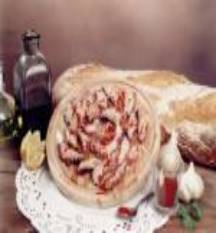 First cook the octopus, boil it without salt and leave it in another place because it must be cold. When it’s cold, cut it. Then cook the peppers and peel it. Make a sauce with garlic, crumb of bread with vine and almonds and hazelnuts.
First cook the octopus, boil it without salt and leave it in another place because it must be cold. When it’s cold, cut it. Then cook the peppers and peel it. Make a sauce with garlic, crumb of bread with vine and almonds and hazelnuts.
In a saucepan put a bit of oil. When it’s hot, add the sauce with a bit of hot water. When it begins to boil, add cut potatoes, the octopus and a bit of salt. Wait until it is culling stew.
6.2. FESTIVITIES:
JANUARY:
- 1st of January: We celebrate beginning of the New Year.
- 6th of January: The three kings come with presents for all the family.
- January: the end of Christmas holidays.
- 20th of January: Festivity in the estate of Clarà...Saint Sebastian.
FEBRUARY:
- 11st of February: Maundy Thursday.
- 14th February: Shrove Tuesday. (Valentine’s Day).
- February or March (depends on the year): Carnival.
MARCH:
![]() - 27th of March: Easter Sunday.
- 27th of March: Easter Sunday.
APRIL:
 - 23rd of April: Saint Jordi, patron of Catalonia.
- 23rd of April: Saint Jordi, patron of Catalonia.
- April: Easter.
MAY:
- 1st of May: Labour Day.
JUNE:
- 23rd of June: Saint Joan. Festivity in the maritime area.
- 24th of June: Midsummer Day.
 - June: Summer holidays begin.
- June: Summer holidays begin.
JULY:
- 15th of July: Local festivity (It’s known as the “festa major petita” and it commemorates when in 1640 the pest disappeared from the village thanks to St. Rosalia.)
The most traditional dance in Catalonia is the “Sardana” (see photo below)

SEPTEMBER:
- 4th of September: The most important festivity in Torredembarra is on Santa Rosalia’s day, the patron saint of the village.
- 11st of September: Catalan Festivity (It commemorates the defeat of Catalonia by the Castillian troupes in 1714).
- September: The end of summer holidays.
NOVEMBER:
- 1st November:All Saint’s Day.
DECEMBER:
 - December: Christmas holidays begin.
- December: Christmas holidays begin.
- 25th of December: Christmas Day.
- 28th of December: Fools’ Day.![]()
 - 31st of December: News year’s Eve.
- 31st of December: News year’s Eve.
6.3. TRADITIONS:
The most popular dances in Torredembarra are:
He’s an old stick dance that has an agricultural meaning. Nine people dance and hit the floor with long sticks made of a branch of a strong tree like an evergreen oak in a symbolic attempt to fertilize the land. The folk clothes of the Torredembarra dance are: a white shirt and trousers and a green waistcoat. They wear small bells which are tied around their legs, canvas sandals and finally a hat hanging on their back.

It’s very similar to the last one. It’s a dance which consists in groups of eight people hitting the floor with sticks while a song is playing. The clothes that the people who dance it wear are: white trousers and a white shirt, a red skirt with a white edging, blue sash, shawl on the chest, bells on the legs and canvas sandals.
It’s a dance in which a lot of people throw firecrackers. The others stay in dawn. They wear a red shirt, red trousers and a hat to protect their head.

It’s a typical Catalan tradition which has it’s origin in the area of Tarragona. It consists in building different human towers. The local group (of Torredembarra) “Colla castellera” is called “Els nois de la Torre”. The “castellers” wear white trousers, a red t-shirt and a band.

They are a sort of dwarves and giants which represent folk figures and were bought by the town hall in 1957-1958 because previously the town hall used to rent them from neighbour towns. Children carry “els nans” and adults carry “els gegants”. These figures dance different tunes.

It started in 1994. This dance symbolizes the fight of four Christian gentlemen against four Turks.
It’s a firework animal incorporated in 1993 in the popular dances of Torredembarra. “L’Àliga” (the eagle) shows the local history and symbolizes the crown that there is in the shield of the village which represents the barony gentlemen of Torredembarra.
It’s the second animal that is related to fertility dances.
Author: Gabriela Gómez